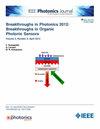Near-Infrared Photodetector Based on UCNPs-Covered Violet Phosphorus
IF 2.1
4区 工程技术
Q3 ENGINEERING, ELECTRICAL & ELECTRONIC
引用次数: 0
Abstract
Violet phosphorus (VP) is a layered material developed in recent years with a tunable bandgap, high carrier mobility, and better thermal stability than its phosphorus allotrope, black phosphorus (BP). The bandgap of VP varies with thickness, ranging from 1.68 to 2.02 eV, with a high responsivity in the visible range. Combining lanthanide-doped upconversion nanoparticles (UCNPs) with VP and taking advantage of the energy transfer between them is a feasible strategy to achieve near-infrared (NIR) photodetection and expand the application scenarios of devices. In this work, we designed a novel strategy for NIR detection by simply combining UCNPs and VP using the spin-coating method. The prepared UCNPs/VP photodetector exhibits an excellent photoresponsivity of 2.8 mA/W and a high specific detectivity of 2.04×10 9 Jones (@ 980 nm, 2.8 mW/cm 2 , 10 V). Compared to the weak photoresponse of bare VP, the UCNPs/VP device shows a significant improvement in photoresponse in the near-infrared band. Additionally, we conducted the photoresponse characterization of the UCNPs/VP device at different temperatures, aiming to enhance its performance by adjusting the temperature. In conclusion, we found that the hybrid device performs better in high-temperature environment. This work provides new ideas and approaches for VP-based optoelectronic devices.基于ucnps包覆紫磷的近红外探测器
紫磷(VP)是近年来发展起来的一种层状材料,具有可调的带隙、高载流子迁移率和比其同素异形体磷黑磷(BP)更好的热稳定性。VP的带隙随厚度的变化而变化,在1.68 ~ 2.02 eV之间,在可见光范围内具有较高的响应率。将掺杂镧系上转换纳米粒子(UCNPs)与VP结合,并利用两者之间的能量传递,是实现近红外(NIR)光探测和扩展器件应用场景的可行策略。在这项工作中,我们设计了一种新的近红外检测策略,通过旋转涂层方法简单地将UCNPs和VP结合起来。制备的UCNPs/VP光电探测器具有2.8 mA/W的优异光响应率和2.04×109 Jones (@ 980 nm, 2.8 mW/cm2, 10 V)的高比探测率,与裸VP的弱光响应相比,UCNPs/VP器件在近红外波段的光响应有显著改善。此外,我们还对不同温度下的UCNPs/VP器件进行了光响应表征,旨在通过调节温度来提高其性能。综上所述,我们发现混合器件在高温环境下性能更好。这项工作为基于vpp的光电器件提供了新的思路和方法。
本文章由计算机程序翻译,如有差异,请以英文原文为准。
求助全文
约1分钟内获得全文
求助全文
来源期刊

IEEE Photonics Journal
ENGINEERING, ELECTRICAL & ELECTRONIC-OPTICS
CiteScore
4.50
自引率
8.30%
发文量
489
审稿时长
1.4 months
期刊介绍:
Breakthroughs in the generation of light and in its control and utilization have given rise to the field of Photonics, a rapidly expanding area of science and technology with major technological and economic impact. Photonics integrates quantum electronics and optics to accelerate progress in the generation of novel photon sources and in their utilization in emerging applications at the micro and nano scales spanning from the far-infrared/THz to the x-ray region of the electromagnetic spectrum. IEEE Photonics Journal is an online-only journal dedicated to the rapid disclosure of top-quality peer-reviewed research at the forefront of all areas of photonics. Contributions addressing issues ranging from fundamental understanding to emerging technologies and applications are within the scope of the Journal. The Journal includes topics in: Photon sources from far infrared to X-rays, Photonics materials and engineered photonic structures, Integrated optics and optoelectronic, Ultrafast, attosecond, high field and short wavelength photonics, Biophotonics, including DNA photonics, Nanophotonics, Magnetophotonics, Fundamentals of light propagation and interaction; nonlinear effects, Optical data storage, Fiber optics and optical communications devices, systems, and technologies, Micro Opto Electro Mechanical Systems (MOEMS), Microwave photonics, Optical Sensors.
 求助内容:
求助内容: 应助结果提醒方式:
应助结果提醒方式:


